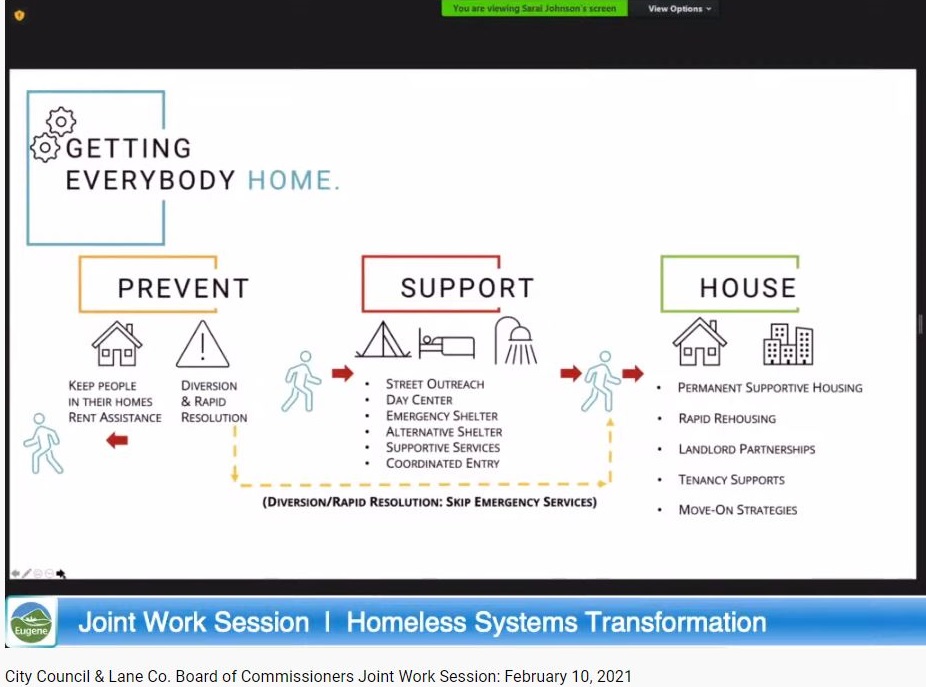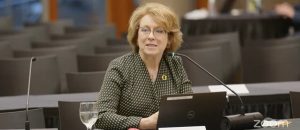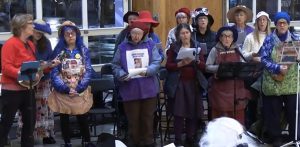Eugene, Lane County may reboot homelessness plan
11 min read
With more than 100 people becoming homeless each month, city and county officials may need a new plan.
With 138 people becoming homeless each month, Eugene and Lane County need a new plan. That was the message from multiple commissioners and council members at a meeting on their joint efforts to address housing needs. Mike Clark and Joe Berney both suggested going back to the drawing board.
Mike Clark: I genuinely believe that we’re going to have an impact over this year that will require us to rethink our goals here and the tactics for getting there. I hope that we will individually as bodies and then collectively reassess that, I really do.
Joe Berney: I personally believe that the world has changed so much in the last two years that I concur with those suggesting we may want to revisit tactics, strategies.
John Q. Murray: Laurie Trieger, Emily Semple, and Lucy Vinis suggested more support for providers and engaging more community groups.
Thank you for supporting
local citizen journalism
Laurie Trieger: We have to shore up our provider community.
Emily Semple: We need to work upstream. We desperately need more providers, mental health, drug addiction.
Lucy Vinis: We’ve actually had a proliferation of kind of new providers, these sort of ad hoc citizen groups that have come together to, to help provide. …I also think of our CERT-trained neighborhood organizations, whether, again, there’s another group that could come in.
John Q. Murray: Matt Keating and Greg Evans highlighted the use of commercial and industrial spaces for emergency shelter.
Matt Keating: I will want to know if there’s exploration beyond hotels or motels to look at former schools or churches or banks, credit unions, empty lots or empty buildings and potential to even explore a vacant lot tax.
Greg Evans: I know that there’s some other cities that have used warehouses and other similar type facilities that they retrofitted to be able to accommodate people with emergency shelter.
John Q. Murray: And Randy Groves recommended finding spaces where people living in their vehicles can park.
Randy Groves: It seems like we have a lack of space for placement for large vehicles.
John Q. Murray: The elected officials made the remarks after hearing a presentation from Sarai Johnson, the joint housing and shelter strategist, who reports to both the City and County. Council member Mike Clark questioned Sarai about the growing numbers of unhoused.
Mike Clark: A hundred new folks a month is the rate of increase, right? Yes. Okay, so this is not hyperbole. I’m asking the question seriously, because I believe that by the time we hit the summer or the fall of this year, what will happen to the system we have planned right now, when that 138 number doubles. That’s a sincere question. What will be the impact?
Sarai Johnson: Great question. I think that the impact would be pretty dire. Obviously we already are having a lot of kind of system capacity issues with that, the number of people who are returning within that 90 days or after their 90 day inactive period. Yeah, ultimately we absolutely have to get better at preventing homelessness which is a big part of the work that we’re trying to do now. And then of course the access to, helping people actually get housed or get into housing as quickly as possible after…
Mike Clark: I think you’ve done a fabulous job of putting the TAC report planning into on-the-ground work. That’s excellent. But I genuinely believe that we’re going to have an impact over this year, that will require us to rethink our goals here and the tactics for getting there. I hope that we will individually as bodies, and then collectively reassess that. I really do.
John Q. Murray: After council member Claire Syrett pointed out that the current plan was designed only for single adults, Lane County Commissioner Joe Berney suggested pivoting to include youth and families.
Joe Berney: I personally believe that the world has changed so much in the last two years that I concur with those suggesting we may want to revisit tactics, strategies. Here’s a couple of things I don’t see in here that is frustrating to me. One of them is how you structure incentives to draw private investments, to partner with public resources, to solve these problems, even homeless shelters.
There are ways to creatively do that. And I encourage that to be incorporated. I may be in the minority, but I agree with Councilor Groves. If we’re going to revisit, we need to include our future and looking at the homeless problem, which is which our youth youth and families that needs to be built in is my opinion.
And finally, I really believe that we need to also present this not in just a systems perspective, systems can get abstract and boring for the general public, but in a client centered approach where clients obviously drive the systems work that is going on. And one can do that. Think of a bullseye, clients in the middle, not the system, and then the system grows around those needs.
I also think that needs to be, I thought there might be a dashboard for this meeting. We discussed that I very much encouraged a public-facing dashboard that we can leverage our wonderful non-profit and business network.
John Q. Murray: Mayor Lucy Vinis looked for more community outreach.
Lucy Vinis: Recognizing that outreach has been so important through this COVID crisis and that we’ve actually had a proliferation of kind of new providers, these sort of ad hoc citizen groups that have come together to, to help provide. And I recognize that best practice is not really on your work plan for the next 12 months, but I do think that that it does call for us to do some capacity building within our provider organizations and some trauma-informed care kinds of responses and a little bit more get our arms around that. It seems to me that’s a potentially a private funded thing. A foundation kind of fun to think and could be important. It’s bringing our, wrapping our arms around it. And this could be a role for the poverty and homelessness board to actually look at that and help orchestrate that. What would that look like?
A lot of those providers come to those meetings. It might be a good place to step up. And I also think of our CERT-trained neighborhood organizations, whether, again, there’s another group that could come in.
John Q. Murray: Commissioner Laurie Trieger suggested outreach to learn how to make it easier for the provider community.
Laurie Trieger: I just don’t think we can emphasize enough how important it is to think about from our respective agencies, the ways, the opportunities we have to shore up our provider community. Whether it’s streamlining RFP processes, increasing, decreasing the administrative percentage costs we ask of them, whatever it may be.
I’m not sure what the mechanisms are for getting feedback from the provider community about what would make it easier for them to do the incredibly difficult work that we’re asking of them and the resources that we’re making available to them to do it with. But that is top of my list of things to make sure we’re always considering. The other is this idea of expanded and coordinated street outreach.
I’m wondering where the opportunities are for engaging the general public in some of this outreach work both for more capacity and because it helps open folks eyes to what the challenges are that you’re being faced. So I would love to hear about where, when we can send folks to want to be engaged on this from the general public agencies to be part of this work.
John Q. Murray: Council member Emily Semple.
Emily Semple: I like to say, ‘No fear of rain, rape, or robbery,’ and we need to get, expand our ideas. What if the earthquake happens, where are we going to put everybody? I don’t wish we had huge camps. In desperate times that’s what happens. And we need to push more for those parking lots and those warehouses where we can put cars and tents and big vehicles and big tents. And we need to work upstream. We desperately need more providers, mental health, drug addiction. Appreciate what we’re doing, and, need more, especially that, where can you sleep tonight? Not everybody is willing to connect with providers. Where do we put them?
John Q. Murray: Council member Randy Groves had two questions for Sarai.
Randy Groves: My specific question, first question is around youth and what we are specifically doing to help them.
Sarai Johnson: There are a lot of liability challenges in working with a minor population that is unaccompanied. So there that’s one of the big things that we have to really dig through and figure out. But along with that, we definitely have a lot of community energy towards this. Youth era has been working on setting up a youth hostel right now at the drop-in center until they could get the right insurance lined up for liability.
Randy Groves: And then my second question, and I actually spoke with the mayor about this yesterday. We have, it seems like we have a lack of space for placement for large vehicles.
Sarai Johnson: We are always looking at sites for anything that we can do. We do have a team made up of Kristie Hammitt and Brooke Freed and Matt Rodriguez from the City of Eugene; Dan Hurley, the public works director at the County, Greg Rikhoff and myself and Lance from Public Works as well. So we have a conversation once a week where we’re looking at specific properties right now that are for sale or lease that could be a land new thing, or I’d rather have a piece of land that we could use or a building of some kind, so we are exploring that all the time. We also always welcome more creativity on that front too. And I know in Eugene it is allowable for a property owner to set up a micro-site as long as they have access to sanitation and hygiene including the trash pickup. So yeah, we have a lot of parking lots and a lot of exploration to do, but yes, it’s really important that we accommodate that.
John Q. Murray: Council member Matt Keating also wanted to look at empty commercial properties.
Matt Keating: 350 beds is woefully inadequate. I’m excited to ramp up Operation Turnkey. It’s not a silver bullet, but it’s one answer among many. And I will want to know if there’s exploration beyond hotels or motels to look at former schools or churches or banks, credit unions, empty lots or empty buildings and potential to even explore a vacant lot tax. At the heart of my concerns, we are in a community in which we have small non-profits. We have a mid-sized city in a large county and big city issues and clearly a service provider capacity [issue].
John Q. Murray: Council member Greg Evans encouraged a solution to reduce the number of camps springing up.
Greg Evans: I know that there’s some other cities that have used warehouses and other similar-type facilities they retrofitted to be able to accommodate people with emergency shelter. So I’m really pleased that we’re pursuing that right now, because I think that will help us with the number of people that we have on the streets right now. And I think that’s, what folks are seeing is, they’re seeing a lot of impromptu camps that are not sanctioned and are basically hot messes, that a number of my constituents would like to see better controlled or at least cleaned up. So hopefully we can get somewhere on that.
John Q. Murray: Commissioner Pat Farr asked Sarai how the City and County might improve their joint partnership.
Pat Farr: My question for you is direct. You report to the County Administrator and the City Manager by job definition. Can you talk about how well your coordination of efforts between the City and the County are going and perhaps hopes that we have for the future to even more closely coordinate those efforts.
Sarai Johnson: Sure, that’s a good question. Yes. So we are a one year and one week exactly into this experiment, at least where I’m concerned. So I’ve spent the last year really trying to get to know the different teams and the different municipalities. I have been really encouraged by the way that the City and the County have been able to work together on something that’s so challenging and that each of these different agencies has different needs and concerns around it. So one of the big parts of what I’ve evolved into trying to do more and better is working with the city in particular on what is, where does the city fit into this work and what is the city’s priority.
John Q. Murray: Mayor Vinis suggested assigning City or County roles based on potential funding sources.
Lucy Vinis: When we look at that TAC report recommendations and those 10 pieces, there are some pieces within that report that are clearly a County role, like the coordinated entry system, clearly a county role. There are other pieces in there where we’re doing two things together, County and City, like the street outreach. We anticipate that working on that permanent shelter together, I think it would be helpful, and maybe we can bring back the steering committee that we had in the first round when we were looking at implementing these recommendations to talk about City roles and County roles, how they currently are laid out. And if there’s, if we want to adjust that, because as we start to talk about funding and what resources are available, I think that will help structure our thinking a little bit about what we each bring to the table, how that looks. So I’d love to see that layout of those recommendations.
John Q. Murray: Council member Alan Zelenka has been working on these issues since before Betty Taylor was elected the very first time.
Alan Zelenka: One of the things that we have to remember about this problem of homelessness, not getting housing for folks, is that there’s a world-class hard problem that nobody’s really solved and it’s been baking for 50 years and we’re not going to change it like that. There, there is no silver bullet. There’s a silver buckshot approach to this. So it’s a lot of a lot of different things that we’re doing. And this approach is like that. So it’s that ever incremental progress that actually helps me quite a bit. It’s the small but steady movement towards getting there. I think to go to the next level though, we need to, it needs, it requires more money. That’s just the simple fact. I think we need to start looking at a bond or a levy to do more stuff and I think the public will support that.




